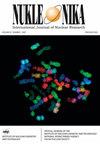Radiation-induced cancer risk and decision-making in a simulated Cs-137 urban event
IF 0.3
4区 物理与天体物理
Q4 CHEMISTRY, INORGANIC & NUCLEAR
引用次数: 5
Abstract
Abstract The triggering of a “dirty bomb” generates a complex scenario, with enormous challenges for the responders due to initial misinformation and the urgency to act quickly yet effectively. Normally, the first 100 h are decisive for perceiving the risk in a more realistic dimension, but the support of methodologies that rely on computational simulations can be valuable when making key decisions. This work seeks to provide support for the early decision-making process by using a Gaussian model for the distribution of a quantity of Cs-137 spread by a radiological dispersive device (RDD). By sequentially joining two independent programs, HotSpot Health Physics codes and RESidual RADiation (RESRAD)-RDD family of codes, we came up with results that suggest a segmented approach to the potentially affected population. These results advocate that (a) the atmospheric stability conditions represented by the Pasquill–Gifford classes and (b) the population subgroups defined by radiation exposure conditions strongly influence the postdetonation radiological effects. These variables should be taken into account in the elaboration of flexible strategies that include many climatic conditions and to priori-tize attention to different groups of public at risk. During the initial phases of such an event, it is believed that simulations using Gaussian models may be of value in anticipating the possible changes in key variables during the decision-making process. These variables may severely affect the effectiveness of the actions of responders and the general public’s safety.模拟Cs-137城市事件中辐射诱导的癌症风险和决策
“脏弹”的触发产生了一个复杂的场景,由于最初的错误信息和快速有效行动的紧迫性,给响者带来了巨大的挑战。通常,前100小时对于在更现实的维度上感知风险是决定性的,但是在做出关键决策时,依赖于计算模拟的方法的支持可能是有价值的。这项工作旨在通过使用高斯模型来计算辐射色散装置(RDD)传播的Cs-137的分布,为早期决策过程提供支持。通过顺序加入两个独立的程序,热点健康物理代码和残余辐射(RESRAD)-RDD代码家族,我们得出的结果表明,对潜在受影响的人群采用分段方法。这些结果表明:(a)以Pasquill-Gifford类别为代表的大气稳定性条件和(b)以辐射暴露条件定义的人口亚群强烈影响爆轰后辐射效应。在制定包括许多气候条件在内的灵活战略时,应考虑到这些变数,并优先注意处于危险中的不同公众群体。在此类事件的初始阶段,人们认为使用高斯模型进行模拟可能对预测决策过程中关键变量的可能变化有价值。这些变量可能严重影响应急人员行动的有效性和公众的安全。
本文章由计算机程序翻译,如有差异,请以英文原文为准。
求助全文
约1分钟内获得全文
求助全文
来源期刊

Nukleonika
物理-无机化学与核化学
CiteScore
2.00
自引率
0.00%
发文量
5
审稿时长
4-8 weeks
期刊介绍:
"Nukleonika" is an international peer-reviewed, scientific journal publishing original top quality papers on fundamental, experimental, applied and theoretical aspects of nuclear sciences.
The fields of research include:
radiochemistry, radiation measurements, application of radionuclides in various branches of science and technology, chemistry of f-block elements, radiation chemistry, radiation physics, activation analysis, nuclear medicine, radiobiology, radiation safety, nuclear industrial electronics, environmental protection, radioactive wastes, nuclear technologies in material and process engineering, radioisotope diagnostic methods of engineering objects, nuclear physics, nuclear reactors and nuclear power, reactor physics, nuclear safety, fuel cycle, reactor calculations, nuclear chemical engineering, nuclear fusion, plasma physics etc.
 求助内容:
求助内容: 应助结果提醒方式:
应助结果提醒方式:


